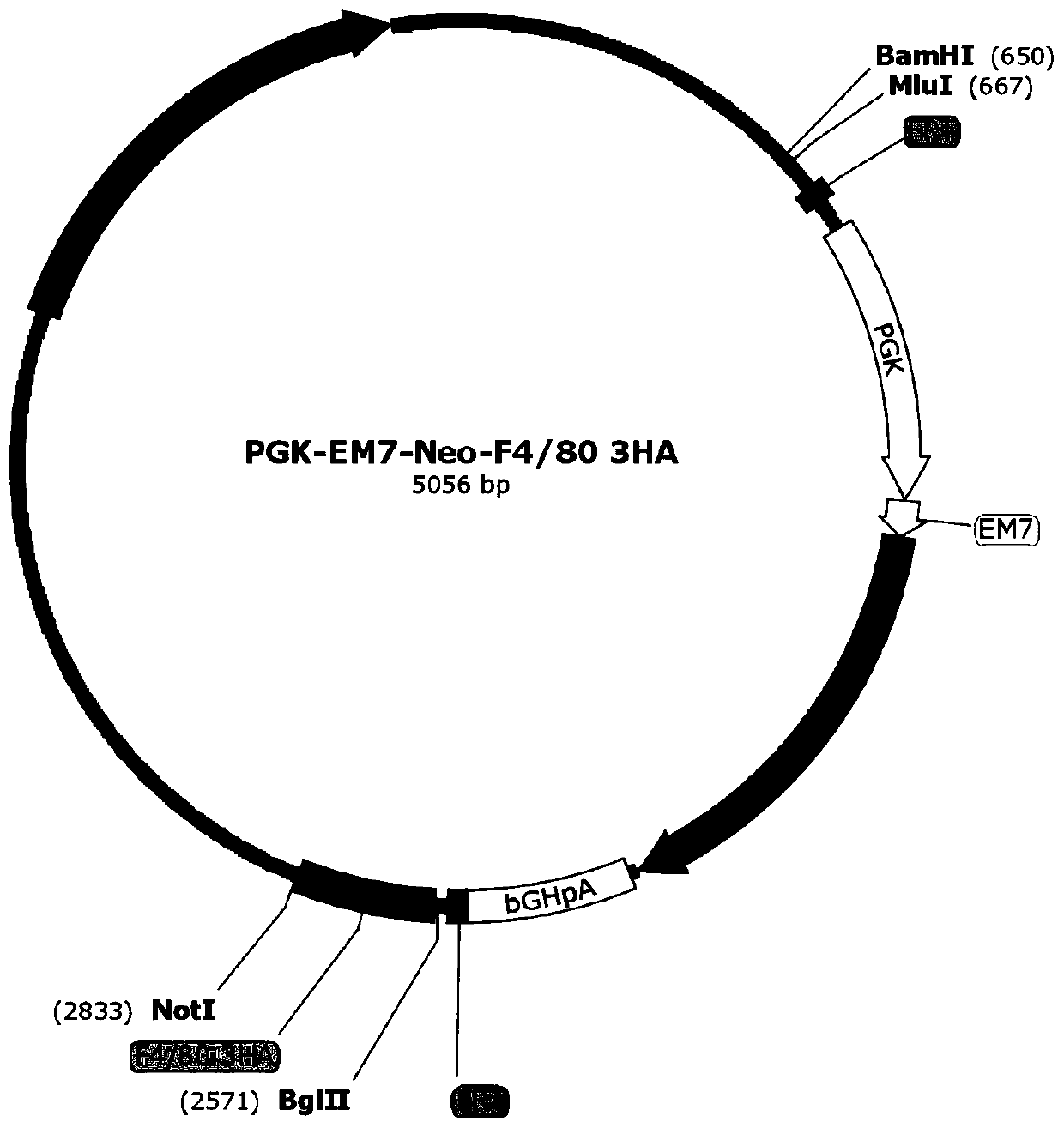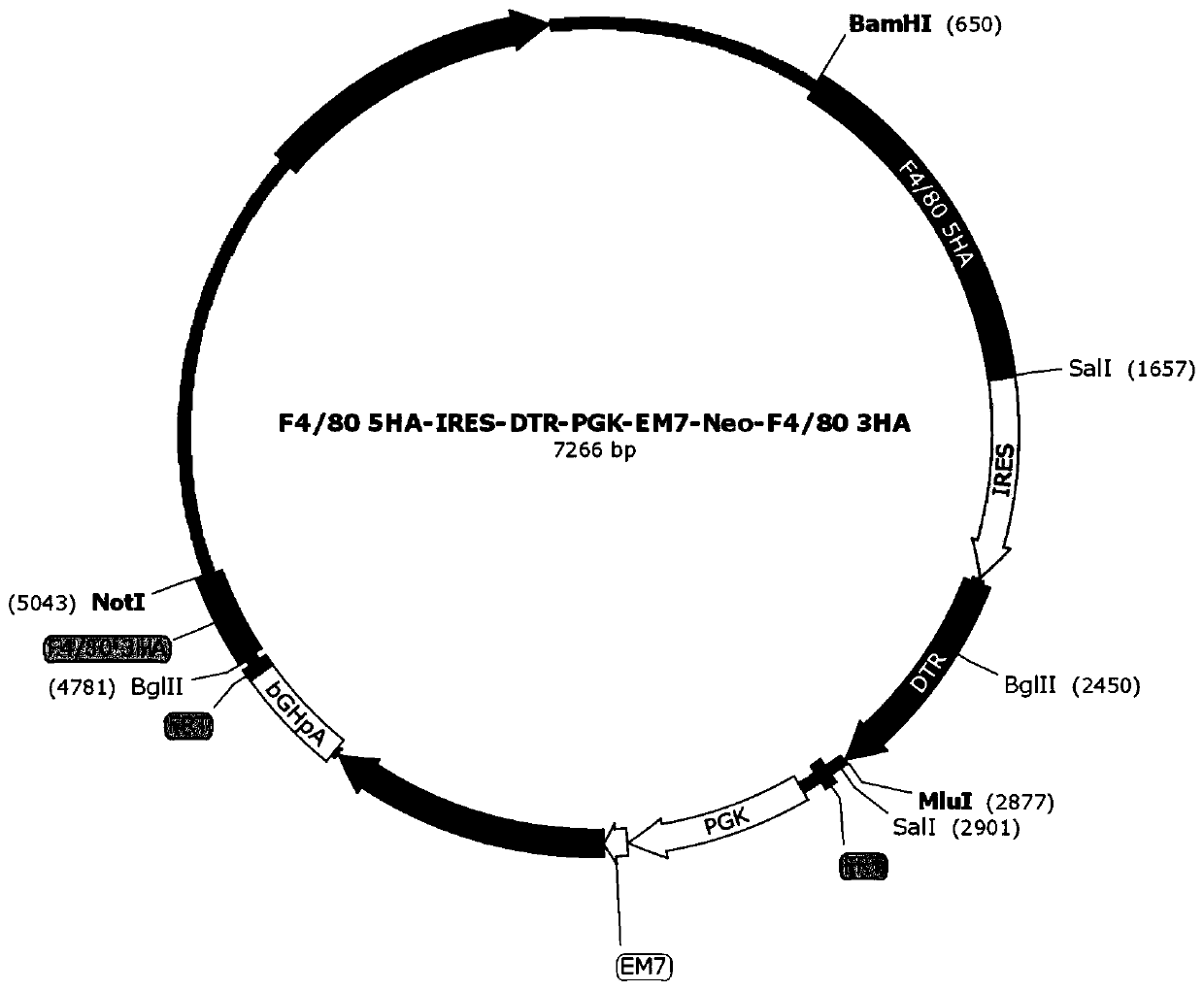Targeted targeting vector, and method and application for targetedly integrating foreign gene to 22nd position of mouse F4/80 exon to construct BAC clone
A technology for targeting vectors and foreign genes, which can be applied to other methods of inserting foreign genetic materials, using vectors to introduce foreign genetic materials, vectors, etc., and can solve problems such as difficulties
- Summary
- Abstract
- Description
- Claims
- Application Information
AI Technical Summary
Problems solved by technology
Method used
Image
Examples
Embodiment 1
[0031] Example 1: Construction of a targeting vector that integrates a foreign gene into exon 22 of mouse F4 / 80
[0032] The mouse F4 / 80 genome sequence was retrieved and downloaded from the genome.ucsc.edu website, combined with the mouse F4 / 80 (Genbank No: NM_010130.4) sequence, the positions and sequences of each exon and intron were determined. The BAC Clone containing the entire F4 / 80 gene: RP23-212F14 was purchased from the Children’hospotal Oakland Research Institute, and the BAC DNA was used HiPure Plasmid Filter Maxiprep Kit (Invitrogen) was prepared for use.
[0033]The target gene fragment F4 / 80 3' side homology arm (F4 / 80 3HA) was amplified by PCR: using RP23-212F14 BACDNA as a template, using the forward primer F4 / 80-3HA-F(BglII)-ACCACC AGATCT AACAATGTCTGAAGATTGTAAGTGC (SEQ ID NO.1), reverse primer F4 / 80-3HA-R(NotI)-AACAAC GCGGCCGC TGTACCGTTGAAATAGGACGTG (SEQ ID NO.2) was used for PCR amplification of the 3' side homology arm F4 / 80 3HA (SEQ ID NO.3). The und...
Embodiment 2
[0048] Example 2: Targeted integration of exogenous genes into mouse F4 / 80BAC using targeting vectors
[0049] Transform pRed / ET into Escherichia coli BAC Clone RP23-212F14 containing the entire F4 / 80 gene by electroporation: inoculate the Escherichia coli BAC Clone RP23-212F14 containing the entire F4 / 80 gene in chloramphenicol (15 μg / mL) LB plates were incubated at 37°C for 16h. Pick one clone and put it in a 2mL centrifuge tube with 1mL LB medium (containing 15 μg / mL chloramphenicol) (a hole is poked in the lid to allow ventilation), and cultivate overnight at 37°C and 200rpm. Take 30 μL of Escherichia coli clone cultured overnight and place it in a 2 mL centrifuge tube with 1.4 mL of LB medium (containing 15 μg / mL chloramphenicol), at 37°C and 1000 rpm, and culture for 2-3 hours to amplify the E. coli in logarithmic phase. The amplified Escherichia coli was centrifuged at 11000rpm at 2°C for 30s, and the supernatant was discarded. The Escherichia coli pellet was washed 3...
Embodiment 3
[0052] Example 3: Screening and identification of BAC clones with targeted integration of exogenous genes into mouse F4 / 80 exon 22
[0053]Colony PCR screening targeting Escherichia coli BAC Clone inserted into IRES-DTR-PGK-EM7-Neo: pick 12 single clones and place them in 1.5mL centrifuge tubes with 10μl ddH2O, and mix them by pipetting. Take 1 μl of bacterial liquid as a template, and use forward primer F4 / 80-189503-F-TGAAATAACCCAGACACAGAGTTT (SEQ ID NO.15) and reverse primer IRES screen-R-CGGCAATATGGTGGAAAATAACA (SEQ ID NO.16) for colony PCR. Add the remaining bacterial solution to a 15mL centrifuge tube containing 5mL LB medium (containing 15μg / mL chloramphenicol, 15μg / mL neomycin), and culture at 220rpm at 37°C for 16h. pRed / ET will be lost at 37°C.
[0054] The colony PCR reaction system is as follows:
[0055]
[0056] The colony PCR reaction conditions were as follows:
[0057]
[0058] The PCR product was identified by 1% agarose gel electrophoresis, and the E....
PUM
 Login to View More
Login to View More Abstract
Description
Claims
Application Information
 Login to View More
Login to View More - R&D
- Intellectual Property
- Life Sciences
- Materials
- Tech Scout
- Unparalleled Data Quality
- Higher Quality Content
- 60% Fewer Hallucinations
Browse by: Latest US Patents, China's latest patents, Technical Efficacy Thesaurus, Application Domain, Technology Topic, Popular Technical Reports.
© 2025 PatSnap. All rights reserved.Legal|Privacy policy|Modern Slavery Act Transparency Statement|Sitemap|About US| Contact US: help@patsnap.com



